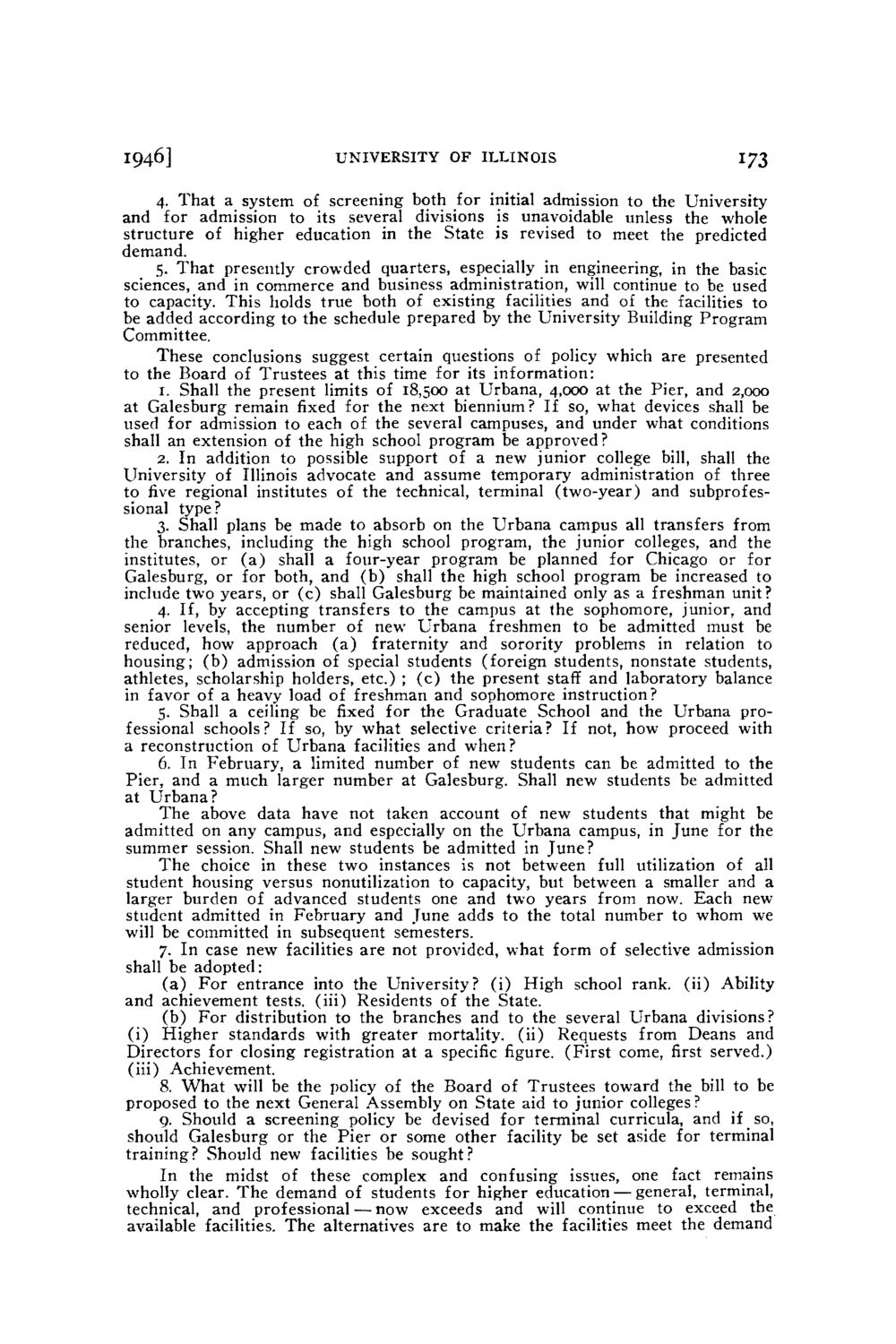| |
| |
Caption: Board of Trustees Minutes - 1948
This is a reduced-resolution page image for fast online browsing.

EXTRACTED TEXT FROM PAGE:
1946] UNIVERSITY OF ILLINOIS m 4. That a system of screening both for initial admission to the University and for admission to its several divisions is unavoidable unless the whole structure of higher education in the State is revised to meet the predicted demand. 5. T h a t presently crowded quarters, especially in engineering, in the basic sciences, and in commerce and business administration, will continue to be used to capacity. This holds true both of existing facilities and of the facilities to be added according to the schedule prepared by the University Building Program Committee. These conclusions suggest certain questions of policy which are presented to the Board of Trustees at this time for its information: 1. Shall the present limits of 18,500 at Urbana, 4,000 at the Pier, and 2,000 at Galesburg remain fixed for the next biennium? If so, what devices shall be used for admission to each of the several campuses, and under what conditions shall an extension of the high school program be approved? 2. In addition to possible support of a new junior college bill, shall the University of Illinois advocate and assume temporary administration of three to five regional institutes of the technical, terminal (two-year) and subprofessional type? 3. Shall plans be made to absorb on the Urbana campus all transfers from the branches, including the high school program, the junior colleges, and the institutes, or ( a ) shall a four-year program be planned for Chicago or for Galesburg, or for both, and (b) shall the high school program be increased to include two years, or (c) shall Galesburg be maintained only as a freshman unit? 4. If, by accepting transfers to the campus at the sophomore, junior, and senior levels, the number of new Urbana freshmen to be admitted must be reduced, how approach ( a ) fraternity and sorority problems in relation to housing; (b) admission of special students (foreign students, nonstate students, athletes, scholarship holders, etc.) ; (c) the present staff and laboratory balance in favor of a heavy load of freshman and sophomore instruction? 5. Shall a ceiling be fixed for the Graduate School and the Urbana professional schools? If so, by what selective criteria? If not, how proceed with a reconstruction of Urbana facilities and when? 6. In February, a limited number of new students can be admitted to the Pier, and a much larger number at Galesburg. Shall new students be admitted at U r b a n a ? The above data have not taken account of new students that might be admitted on any campus, and especially on the Urbana campus, in June for the summer session. Shall new students be admitted in J u n e ? T h e choice in these two instances is not between full utilization of all student housing versus nonutilization to capacity, but between a smaller and a larger burden of advanced students one and two years from now. Each new student admitted in February and J u n e adds to the total number to whom we will be committed in subsequent semesters. 7. In case new facilities are not provided, what form of selective admission shall be adopted: ( a ) F o r entrance into the University? (i) High school rank, (ii) Ability and achievement tests, (iii) Residents of the State. (b) For distribution to the branches and to the several Urbana divisions? (i) Higher standards with greater mortality, (ii) Requests from Deans and Directors for closing registration at a specific figure. (First come, first served.) (iii) Achievement. 8. W h a t will be the policy of the Board of Trustees toward the bill to be proposed to the next General Assembly on State aid to junior colleges? 9. Should a screening policy be devised for terminal curricula, and if so, should Galesburg or the Pier or some other facility be set aside for terminal training? Should new facilities be sought? In the midst of these complex and confusing issues, one fact remains wholly clear. T h e demand of students for higher education — general, terminal, technical, and professional — now exceeds and will continue to exceed the available facilities. The alternatives are to make the facilities meet the demand
| |